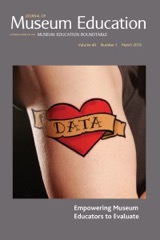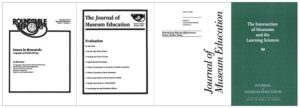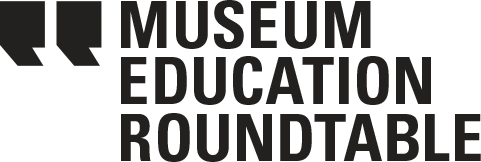Looking Back: Evaluation & Research
For several years now I have served on the selection committee for the California Association of Museums’ Superintendent’s Awards for Excellence in Museum Education. As a requirement of the nominations process, applicants must describe their program evaluation methodology. In reviewing these statements, I have found that some museum educators and their institutions show sophistication and in-depth understanding of processes as they systematically measure their program outcomes, while others lag behind in their ability to gather and analyze data in order to improve practice.
 The recently released March 2015 JME issue Empowering Museum Educators to Evaluate (Vol.40 No.1) will be of great help to some of my colleagues who are still challenged by evaluation. Guest edited by experienced evaluators Joy Kubarek and Laureen Trainer, the articles offer tools and case studies that will help us all improve practice whether we are knowledgeable about evaluation, or not. In the issue, models abound for your team to consider as they work to embed evaluation into everyday practice.
The recently released March 2015 JME issue Empowering Museum Educators to Evaluate (Vol.40 No.1) will be of great help to some of my colleagues who are still challenged by evaluation. Guest edited by experienced evaluators Joy Kubarek and Laureen Trainer, the articles offer tools and case studies that will help us all improve practice whether we are knowledgeable about evaluation, or not. In the issue, models abound for your team to consider as they work to embed evaluation into everyday practice.
As part of this looking back/looking forward blog series on the JME, I wanted to see how our current evaluation issue fits in with others that came before it. I skimmed through back issues of the JME then dove more deeply into four dedicated to evaluation and research. This review barely touches the surface of what our deep archive offers. The process showed me that my belief that we need to systematically study our visitors is one shared by many!
In 1982, just seven years into its 40 volume run, MER published the first issue dedicated to “visitor research” under the auspices of our initial publication namesake, The Roundtable Reports. Guest edited by academic Edward Munyer, Issues in Research Language and Methodology (Vol.7 No.4) offered work by 22 authors writing five articles that addressed tools and ideas for understanding audiences, along with an additional five “reviews of research” that provided specific case studies.
In this very first evaluation-focused issue, Sandra K. Mims authored an article entitled “Language of Research for Museum Education,” where she called for “museum education to build its own substantial base of scholarly research with which to explain and justify its practices, as well as to substantiate and promote new ideas.” At the time there was so much activity in the field that there were enough articles to produce not only one issue, but also another that following winter. Early on the journal editors understood that educators needed to learn more about how to systematically and reliably understand visitors’ learning. Over the next thirty years, the JME periodically filled Mims’ request for research with issues dedicated to evaluation and research.
In 1987, still publishing in our Roundtable Reports format, evaluation luminary Beverley Serrell partnered with Ken Yellis, a longtime editorial force within the JME, to produce an issue with eight articles titled: Evaluation (Vol.12 No.1). The two editors commented on the state of the field at the time in their opening comment titled, Evaluation—What’s the Point. Their remarks still resonate: “This issue of the [now called] Journal of Museum Education: Roundtable Reports attempts to a take a common sense approach to the biggest scare word in the lexicon of museum education. Our purpose is to demystify and defang the subject…” They went on to argue that evaluation is a management as well as a teaching and learning tool that we can use to help us create informed decisions. Most of the projects detailed in this issue aimed to solve “real-museum world” problems.

In 1991 a cluster of interested professionals founded the Visitor Studies Association, which indicated growing interest in developing effective evaluation practice. By 1996, when the JME published the thematic issue: Determining Museum Effectiveness: Visitor Studies Today (Vol.21 No.3), the evaluation field had developed and the authors of the articles that appear in this issue remain well known even today for their work in establishing the need and value of evaluation practice. In her overview statement for the issue, guest editor Kris Morrissey set the scene as she mentioned IMLS funds for learning, increased interest in understanding visitors, and visitor-focused ideas like exhibit developer Judy Rand’s Visitor’s Bill of Rights. Topics discussed in this issue still reverberate today: evaluation versus research; who is qualified to conduct visitor studies; and what models of learning support the museum education field.
In 2008 the JME swung back to a research perspective under the theme of The Intersection of Museums and the Learning Sciences (Vol.33 No.2). Editors Heather Toomey Zimmerman and Sandra Toro Martell, both academics, wrote: “Our goal is to provide new conceptual and methodological tools to both museum educator and learning scientists as they engage in understanding and shaping learning.” This issue’s articles reported on several evaluator/researcher projects and showed how our methods and concepts for understanding our visitors’ learning have expanded over time.
While reading these focused back issues I noticed that we periodically reframe what we call and how we describe the act of studying our visitors: be it as Research, Evaluation, Visitor Studies, or the Learning Sciences. The terminology shifts as we refine our perspectives and methods in order to systematically understand the visitor experience. In all fairness then, given all of these changes in thinking, I probably should not be surprised that some of the program evaluation statements I read as an award selection committee member do not reflect current trends, as evaluation remains a specialized and ever-evolving field. Yet, there are a variety of resources to support educators in adopting a cutting-edge evaluation mindset: JME articles can guide the way.
So, if you are not as grounded in evaluation methods as you sense you should be, or even if you are: allow me another shout out to the latest JME issue on evaluation. As its title makes clear, the goal is to empower you with evaluation know-how. MER’s Editorial Team has produced a Reader Guide to accompany Joe Heimlich’s article The Ethics of Evaluation in Museums. I suggest you download it, then gather some of your colleagues to discuss the questions offered. From there, move on to read the rest of the issue—I guarantee that it will boost your evaluation confidence. And if inspired, you too can delve back into our extensive archives and see how the field has considered evaluation. In the comments, please offer what you use to guide your evaluation practice, be it different JME articles or other resources.
Susan Spero, Ph.D. teaches Museum Studies at the John F. Kennedy University in Berkeley, CA and serves on the Board of the Museum Education Roundtable.

